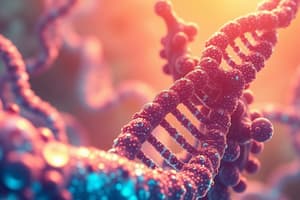Podcast
Questions and Answers
Who pioneered single-cell RNA sequencing?
Who pioneered single-cell RNA sequencing?
- James Eberwine
- Both Norman Iscove and James Eberwine (correct)
- Neither Norman Iscove nor James Eberwine
- Norman Iscove
What is a common cause of resistance to cancer therapy?
What is a common cause of resistance to cancer therapy?
- Overexpression of genes
- Underexpression of genes (correct)
- Proper functioning of cells
- Normal expression of mRNA
Which technique involves linear amplification by in vitro transcription and exponential amplification by PCR?
Which technique involves linear amplification by in vitro transcription and exponential amplification by PCR?
- Protein microarrays
- Gene expression profiling
- Mass spectrometry
- Single-cell RNA sequencing (correct)
What is the primary goal of the Human Cell Atlas project?
What is the primary goal of the Human Cell Atlas project?
Which technology provides separation, detection, and identification of peptides and proteins?
Which technology provides separation, detection, and identification of peptides and proteins?
What is the purpose of analyzing more than a million cells within the next 5 years?
What is the purpose of analyzing more than a million cells within the next 5 years?
Flashcards are hidden until you start studying
Study Notes
Genomic Study Overview
- Comprehensive genomic studies integrate various biological fields to explore cellular, tissue, or organism functions.
- Key technologies include DNA sequencing, which involves analyzing nucleotide sequences in DNA or RNA, and identifying mutations.
Early Sequencing Techniques
- Maxam-Gilbert sequencing marked a milestone in DNA sequencing, developed by Walter Gilbert and Allan Maxam in 1973, focusing on nucleotide sequence determination.
- This method uses chemical degradation to cleave DNA at specific sites, revealing short fragments but involves hazardous chemicals and is time-consuming.
Sanger Sequencing
- Sanger sequencing, introduced in 1975 by Fredric Sanger, employs a chain termination method, offering a safer alternative to earlier techniques.
- The Human Genome Project (1990-2003) utilized Sanger sequencing to map the entire human genome, totaling 3.2 billion base pairs and approximately 25,000 genes.
Next-Generation Sequencing (NGS)
- NGS emerged in the mid to late 1990s, enhancing DNA sequencing through advanced computational techniques, allowing high-throughput sequencing of multiple samples.
- Cost of genome sequencing has dramatically decreased from $100 million in 2001 to less than $10,000 in 2014 due to NGS innovations.
Proteomics Investigation Areas
- Features key areas such as protein 3D structure prediction, localization of synthesis, production rates, and modifications.
- Emphasizes the importance of proteins in metabolic pathways and their interactions.
Human Proteins
- The top eight protein functions in the human body account for 76.20% of the genome, encompassing enzymes, modulators, signaling molecules, receptors, and more.
- Total number of genes involved: 13,098 across various functions like transcription factors and transporters.
Proteomics Technologies
- One- and two-dimensional gel electrophoresis help identify protein mass and isoelectric points.
- X-ray crystallography and NMR are essential for characterizing protein structures.
- Tandem mass spectrometry, often combined with chromatography, quantifies proteins in cells.
- Mass spectrometry identifies proteins through peptide mass fingerprinting and is sometimes paired with high-resolution techniques.
Nanopore Sequencing
- Oxford Nanopore Technologies offers portable sequencing devices like MinION and PromethION, reliant on varying nucleotide sizes and electrical signatures.
- Sequencing utilizes a steady current to detect changes as DNA strands pass through nanopores, enabling rapid sequencing but with a higher error rate.
Innovations in Transcriptomics
- Transcriptomics focuses on mRNA profiles at the single-cell level, revealing transcriptome heterogeneity essential for understanding cell origins and development.
- In cancer research, studying tumor cell transcriptomes aids in discerning cell roles in tumor progression, therapy resistance, and treatment efficacy.
Studying That Suits You
Use AI to generate personalized quizzes and flashcards to suit your learning preferences.




